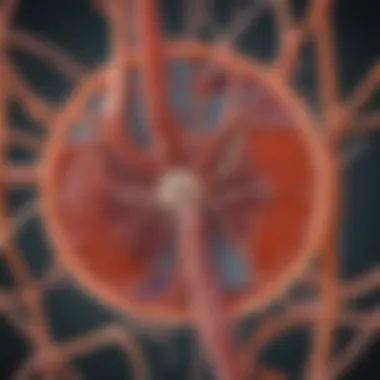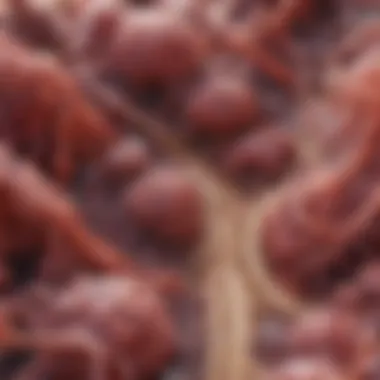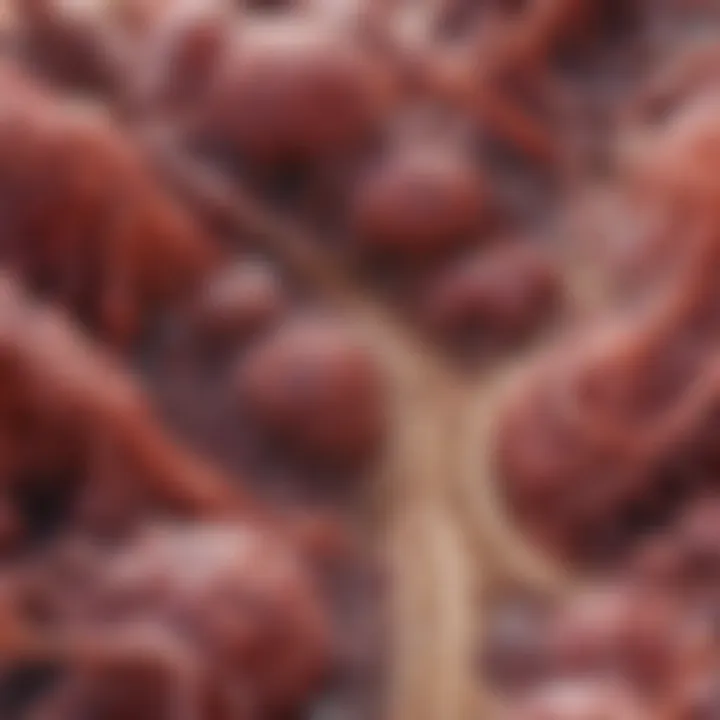Chronic Kidney Disease Pathophysiology Explained


Overview of Research Topic
Brief Background and Context
Chronic kidney disease (CKD) is a progressive condition characterized by the gradual loss of kidney function over time. The kidneys play a crucial role in filtering waste products from the blood, regulating fluid, electrolytes, and acid-base balance. When damaged, these vital processes become compromised, leading to the accumulation of toxins in the body, which can have serious health implications. CKD affects millions globally, with high prevalence in populations with comorbid conditions such as diabetes and hypertension. Understanding the pathophysiology of CKD is essential for timely intervention and management strategies.
Importance in Current Scientific Landscape
The significance of CKD research extends beyond its direct health implications. As global health organizations prioritize the prevention and management of chronic diseases, CKD stands out due to its increasing incidence and association with other systemic diseases. Investigating the underlying mechanisms that contribute to kidney damage provides insight into potential therapeutic targets. Moreover, as healthcare resources become strained, understanding CKD can help in developing more efficient preventive strategies, ultimately improving patient outcomes and reducing healthcare costs.
Methodology
Research Design and Approach
The investigation of chronic kidney disease involves a multi-faceted approach, integrating clinical, laboratory, and pathological data to uncover the molecular and cellular mechanisms at play. Various epidemiological studies, clinical trials, and laboratory experiments contribute to this field. By employing both observational and interventional designs, researchers can delineate the factors that influence CKD progression.
Data Collection Techniques
Data related to CKD is procured from a variety of sources. Patient information collected through clinical registries, observational cohorts, and randomized controlled trials offers rich insights into disease prevalence, treatment protocols, and patient experiences. Additionally, biological samples, including blood and urine, allow for in-depth analysis of biomarkers associated with CKD. Imaging techniques such as ultrasound and MRI provide critical data regarding structural changes in the kidneys. Together, these methodologies facilitate a comprehensive understanding of CKD's pathophysiology and its clinical implications.
"An in-depth analysis reveals that both environmental and genetic factors play a crucial role in the development of CKD."
Through this structured approach, we can begin to comprehend the myriad factors influencing chronic kidney disease and its associated challenges.
Preamble to Chronic Kidney Disease
Chronic Kidney Disease (CKD) is an increasingly pertinent issue in global health. The gradual loss of kidney function poses significant health risks and presents economic burdens on healthcare systems. Understanding the mechanisms behind CKD is essential for effective management and treatment. The complexities of this condition necessitate a comprehensive examination of its pathophysiology, which is the focus of this article.
Definition and Epidemiology
CKD is characterized by a progressive decline in kidney function over time, often leading to end-stage renal disease. According to the KDIGO guidelines, it is defined as a reduction in kidney function, typically measured by the glomerular filtration rate (GFR), lasting for three months or more. Epidemiologically, CKD is a significant health problem, affecting approximately 10-15% of the global population.
The prevalence of CKD varies by region, influenced by factors such as age, sex, and underlying health conditions. Notably, diabetic nephropathy and hypertension are among the leading causes of CKD worldwide. The increasing rates of these conditions contribute to the rising incidence of CKD, emphasizing the urgency of understanding and addressing its impact.
Importance of Understanding Pathophysiology
Grasping the pathophysiology of CKD is paramount for several reasons. First, it allows healthcare professionals to identify the underlying causes of kidney dysfunction. Knowing how conditions like diabetes and hypertension lead to CKD enables targeted interventions. Second, understanding these mechanisms aids in the development of new therapeutic strategies. Recent research has highlighted the roles of nephron damage, glomerulosclerosis, and tubular injury, which can guide treatment protocols.
Finally, a solid grasp of CKD pathophysiology enhances patient education. Patients who understand their condition are more likely to engage in lifestyle modifications and adhere to treatment plans. Overall, improving knowledge of CKD's mechanisms is crucial for reducing its prevalence and alleviating its burden in patients and healthcare systems alike.
"The understanding of CKD not only paves the way for better clinical outcomes but also fosters informed patient engagement and advocacy."
By examining the detailed aspects of CKD, this article aims to shed light on the significant implications for patient care and the future of renal health.
Anatomy of the Kidney
Understanding the anatomy of the kidney is fundamental for grasping the complexities of chronic kidney disease (CKD). The kidneys, two bean-shaped organs located in the lower back, play a pivotal role in maintaining homeostasis within the body. Their intricate structure allows them to perform numerous functions crucial for overall health. By examining the anatomy, we can appreciate how disruptions to the kidney's design can lead to significant pathological consequences.
The primary functional unit of the kidney is the nephron. Each human kidney contains approximately one million nephrons. These nephrons consist of various parts that work cohesively to filter blood, reabsorb vital substances, and excrete waste. A single nephron involves structures such as the glomerulus and the renal tubule, which are essential in the filtration process. Understanding their individual roles helps elucidate how nephron loss contributes to CKD progression.
Structure of Nephrons
Nephrons are composed mainly of two major parts: the renal corpuscle and the renal tubule.
- Renal Corpuscle: This structure includes the glomerulus, a network of capillaries that filters blood, and the Bowman’s capsule, which encases the glomerulus. The filtration barrier created here is selective, allowing water and small solutes to pass while retaining larger molecules and blood cells.
- Renal Tubule: The tubule is further divided into several segments, including the proximal convoluted tubule, the loop of Henle, and the distal convoluted tubule. Each segment plays a distinct role in the reabsorption and secretion of substances necessary for maintaining the body’s electrolyte balance and acid-base homeostasis.
The nephron's structure is fine-tuned for its function, where any structural damage or loss due to disease processes, like glomerulosclerosis or tubular injury, can lead to impaired kidney function. This relationship between structure and function becomes especially critical in understanding CKD and its management.
Kidney Functions


The kidneys are multifunctional organs that perform several key responsibilities:
- Filtration: They filter blood to remove waste products, excess salts, and fluids.
- Regulation of Blood Pressure: By adjusting fluid balance and secreting the hormone renin, they help regulate blood pressure levels.
- Electrolyte Balance: Kidneys maintain the balance of electrolytes such as sodium, potassium, and calcium, which are vital for cellular functions.
- Acid-Base Balance: They regulate the pH of blood by excreting acids or bases as necessary.
- Production of Hormones: Kidneys produce erythropoietin, which stimulates red blood cell production, and calcitriol, the active form of vitamin D.
The seamless operation of these functions underscores the importance of kidney anatomy. Disruptions to the nephron structure can trigger cascading effects, amplifying the severity of chronic kidney disease and complicating patient management. Understanding these anatomical details equips healthcare professionals with the knowledge needed to tackle CKD more effectively.
“The intricate architecture of the kidney not only supports its diverse functions but is also a key factor in the pathophysiology of chronic kidney disease.”
Hence, a comprehensive look into the anatomy of the kidney provides crucial insights into the mechanisms underlying CKD, reinforcing the need for targeted therapeutic strategies.
Etiology of Chronic Kidney Disease
The etiology of chronic kidney disease (CKD) is vital for understanding how kidney function deteriorates over time. Identifying the underlying causes allows both healthcare professionals and patients to make informed decisions regarding prevention and management. CKD can result from various factors, making awareness of these factors essential for both treatment options and lifestyle modifications.
Common Risk Factors
Several risk factors are associated with the development of CKD. Recognizing these can lead to better preventive strategies.
- Hypertension: High blood pressure is a primary risk factor for CKD. When blood pressure remains elevated, it can cause prolonged damage to blood vessels in the kidneys, leading to nephron loss.
- Diabetes: Diabetes, particularly type 2, is another major contributor. Over time, high sugar levels can damage kidneys' filtering system, promoting CKD progression.
- Age: Aging is a non-modifiable risk factor. Older individuals have a greater likelihood of experiencing a decline in kidney function.
- Obesity: Excess body weight increases the risk of hypertension and diabetes, acting as a catalyst for CKD.
- Smoking: Tobacco use can reduce blood flow to the kidneys, contributing to their impairment.
- Family History: A familial predisposition can elevate risk factors, indicating genetic components that warrant consideration.
"Understanding these risk factors is crucial to proactively managing and potentially reversing CKD before it progresses to advanced stages."
Genetic Predispositions
Genetic factors play a significant role in CKD risk. Certain inherited conditions can predispose individuals to kidney disease.
- Polycystic Kidney Disease (PKD): This genetic disorder leads to the formation of fluid-filled cysts in the kidneys, causing dysfunction.
- Alport Syndrome: Another hereditary condition that affects the kidneys and leads to progressive renal failure.
- Genetic Markers: Research is ongoing to identify specific genetic markers that increase susceptibility to CKD. Identifying these markers can assist in early diagnosis and targeted therapies.
In summary, understanding both common risk factors and genetic predispositions is crucial in CKD etiology. This knowledge supports targeted prevention and intervention strategies, ultimately improving patient outcomes.
Pathophysiological Changes in CKD
Understanding pathophysiological changes in chronic kidney disease (CKD) is essential. These changes are indicative of how the disease progresses and can help in devising effective treatments. Knowledge of the mechanisms affecting kidney function sheds light on the broader impact of CKD on bodily systems. Furthermore, these pathophysiological changes provide critical insights into potential therapeutic targets and prevention strategies.
Nephron Loss and Glomerulosclerosis
Nephron loss signifies a key feature in the advancement of CKD. Nephrons, the functional units of the kidneys, are responsible for filtering blood and regulating fluid balance. Over time, various pathological processes can lead to the destruction of these nephrons. Glomerulosclerosis is a condition where glomeruli, clusters of capillaries in nephrons, undergo scarring. This damage can stem from hypertension, diabetes, and other factors, severely impairing kidney function.
The progressive loss of nephron mass leads to compensatory hyperfiltration in the remaining nephrons. This response, while initially beneficial, ultimately exacerbates injury and accelerates the decline of renal function. As nephron loss continues, the kidneys struggle to maintain homeostasis, leading to a cascade of systemic effects.
"Nephron loss and the consequent glomerulosclerosis play a critical role in the progression of chronic kidney disease, leading to proteinuria and ultimately renal failure."
Several factors can contribute to nephron loss, including:
- Hypertension: High blood pressure places undue strain on nephrons, worsening glomerular damage.
- Diabetes mellitus: Hyperglycemia can lead to metabolic changes that promote glomerular harm.
- Inflammatory responses: Chronic inflammation can cause fibrosis, sequentially leading to nephron loss.
Understanding nephron loss and glomerulosclerosis allows researchers and clinicians to develop early interventions to halt or reverse these processes.
Tubular Injury Mechanisms
In addition to nephron loss, tubular injury represents another significant aspect of CKD progression. Tubular cells are responsible for reabsorbing nutrients and electrolytes and secreting waste products. Injury to these cells can lead to impaired function, contributing to the overall decline in kidney health.
Common mechanisms of tubular injury include:
- Ischemia: An insufficient blood supply can quickly damage tubular cells, especially in patients with cardiovascular issues.
- Nephrotoxicity: Exposure to certain drugs or toxins can cause direct injury to tubules. Examples include non-steroidal anti-inflammatory drugs (NSAIDs) and specific antibiotics.
- Inflammatory processes: Cytokines and other inflammatory mediators released during damage can further exacerbate injury.
As tubular injury progresses, it contributes to disturbances in acid-base balance and electrolyte regulation. This, in turn, affects not only kidney function but can also lead to systemic complications such as metabolic acidosis and electrolyte imbalances.
Systemic Effects of CKD
Chronic Kidney Disease (CKD) does not only affect the kidneys themselves; its effects permeate various systems within the body. Understanding the systemic repercussions of CKD is vital for grasping how this disease influences overall health and for recognizing the interconnected nature of bodily systems. This section focuses on specific systemic effects that arise due to CKD, particularly within the cardiovascular and metabolic domains. By examining these aspects, patients and healthcare providers can better manage the implications of CKD, ultimately improving patient outcomes.


Impact on the Cardiovascular System
The relationship between CKD and cardiovascular health is particularly compelling. The risk of cardiovascular complications significantly increases as kidney function declines. This can be attributed to several factors:
- Hypertension: CKD often leads to increases in blood pressure. When kidneys are damaged, they become less efficient at regulating fluid balance, which can elevate blood pressure levels.
- Vascular calcification: Patients with CKD frequently experience changes in mineral metabolism, causing calcium to deposit in the blood vessels. This process can lead to stiffening of arteries, posing further risks for heart disease.
- Increased left ventricular hypertrophy: The heart works harder to pump blood against higher resistance, resulting in structural changes in the heart muscle that can lead to heart failure.
Individuals with CKD should be regularly monitored for cardiovascular health. Preventative measures, such as managing blood pressure and addressing dyslipidemia, are critical in reducing cardiovascular risks.
"Understanding the link between CKD and cardiovascular disease is essential for developing effective treatment strategies."
Metabolic Consequences
Chronic Kidney Disease also brings complex metabolic disturbances, affecting numerous biochemical processes within the body.
- Fluid and electrolyte imbalance: As kidney function diminishes, the body's ability to excrete excess fluid and maintain electrolyte levels becomes compromised. This can lead to conditions such as hyperkalemia, which is high potassium levels in the blood that can cause serious heart issues.
- Acidosis: The kidneys play a key role in regulating acid-base balance. With CKD, there is a tendency towards metabolic acidosis, which can further complicate patient management.
- Uremic syndrome: As waste products accumulate in the body due to impaired kidney function, symptoms such as nausea, weakness, and cognitive dysfunction can arise. Uremia is a significant aspect of CKD that requires careful consideration in treatment plans.
These metabolic consequences necessitate individualized patient care strategies. Regular monitoring of kidney function and metabolic parameters can help in mitigating the adverse effects of CKD on overall health.
Molecular Pathways in CKD Progression
Understanding the molecular pathways in chronic kidney disease (CKD) progression is critical for grasping the complexities of the condition. These pathways encompass various biochemical processes that lead to the deterioration of kidney function over time. The interplay of these mechanisms reflects a multifaceted approach to both the causes and consequences of CKD. Highlighting these pathways not only aids in identifying potential therapeutic targets but also enriches our understanding of disease management and patient care.
Role of Inflammation
Inflammation plays a crucial role in the progression of CKD. The presence of inflammatory cytokines, such as interleukin-1 and tumor necrosis factor-alpha, contributes to renal injury and subsequent loss of function. Inflammatory processes begin at the cellular level and can escalate, leading to organ-wide implications. For instance, activated immune cells infiltrate the kidneys, promoting a cycle of tissue damage and further inflammation.
This intricate response often results in glomerulosclerosis and tubular atrophy, exacerbating kidney dysfunction. Monitoring inflammatory markers can inform clinicians about disease severity and progression. Reducing inflammation through various approaches can potentially slow the progression of CKD, making this a focal point for ongoing research and treatment strategies.
"Inflammation is a key driver in CKD progression and understanding this pathway is essential for effective management."
Fibrosis and Extracellular Matrix Remodeling
Fibrosis is a prominent feature of CKD, characterized by excessive accumulation of extracellular matrix components. This process is largely mediated by myofibroblasts, which arise from various sources including resident fibroblasts and epithelial cells. When the kidneys are subjected to prolonged injury, a cycle of cellular damage, inflammation, and fibrosis ensues. Eventually, these changes lead to scarring and loss of kidney architecture.
The extracellular matrix itself undergoes remodeling in response to injury, influencing the functional capabilities of the kidney. Key molecules involved in this remodeling process include transforming growth factor-beta and connective tissue growth factor. Increased fibrosis often correlates with worsening renal function and higher rates of morbidity. Understanding the mechanisms of fibrosis could open avenues for novel treatments, focusing on halting or reversing these structural changes in the kidneys.
Clinical Implications of CKD
Understanding the clinical implications of chronic kidney disease (CKD) is crucial. This topic affects not only patient management but also has broader implications on healthcare systems globally. CKD’s gradual progression can lead to end-stage renal disease (ESRD), necessitating dialysis or kidney transplantation. Therefore, early detection and management are pivotal in improving outcomes and reducing healthcare costs. The management strategies must take into account the individual variability among patients, emphasizing a tailored approach to treatment.
Diagnostic Approaches
Accurate diagnosis of CKD is essential for effective management. Various diagnostic methods are used to assess kidney function and identify the underlying causes of CKD. Key tests include:
- Serum creatinine levels: This test provides information on kidney filtration capability. Elevated levels indicate impaired function.
- Urine tests: Analyzing urine can reveal proteinuria, hematuria, or specific gravity, all of which are significant indicators of kidney health.
- Imaging studies: Techniques like ultrasound or CT scans help visualize structural abnormalities in kidneys.
- GFR estimation: The glomerular filtration rate (GFR) is a critical metric that quantifies kidney performance.
These diagnostic tools help clinicians ascertain the stage of kidney disease and inform treatment plans. Early identification fosters timely interventions, which can significantly alter disease trajectories and influence patient quality of life.
Staging of CKD
Classifying CKD into distinct stages assists in understanding disease progression and guiding management decisions. The most commonly used system is the National Kidney Foundation's GFR-based classification, which has five stages:
- Stage 1: Normal or increased GFR (≥ 90 mL/min/1.73 m²) with kidney damage.
- Stage 2: Mildly decreased GFR (60-89 mL/min/1.73 m²).
- Stage 3: Moderately decreased GFR (30-59 mL/min/1.73 m²). This stage is often where complications start to arise.
- Stage 4: Severely decreased GFR (15-29 mL/min/1.73 m²), necessitating preparation for dialysis or transplantation.
- Stage 5: Kidney failure (GFR 15 mL/min/1.73 m²), requiring dialysis or renal replacement therapy.
The staging system allows for tailored clinical approaches. It helps health professionals assess the risk for cardiovascular disease, monitor complications, and optimize treatment regimens as necessary.
Understanding and assessing the clinical implications of CKD plays a vital role in enhancing patient outcomes and ensuring sustainable healthcare solutions.
Management Strategies for CKD
Management strategies in chronic kidney disease (CKD) are critical in slowing its progression and minimizing complications. Given the complexities of CKD, these strategies must be multifaceted, combining both pharmacological and lifestyle interventions to optimize patient outcomes. Effective management not only focuses on preserving kidney function but also aims to mitigate the systemic effects that CKD has on the body. It is essential for healthcare providers to assess individual patient needs and tailor management plans accordingly, considering the unique aspects of each patient’s health status, comorbidities, and lifestyle.


Pharmacological Interventions
Pharmacological interventions in CKD are designed to address several key areas: controlling blood pressure, managing diabetes, and influencing the underlying pathophysiological processes. Medications such as angiotensin converting enzyme (ACE) inhibitors and angiotensin receptor blockers (ARBs) are frequently used to manage hypertension. These drugs not only lower blood pressure but also have protective effects on the kidneys. The use of diuretics can help manage fluid overload, particularly in advanced stages of CKD.
Patients with diabetes also need careful monitoring. Glucose-lowering medications, including metformin and SGLT2 inhibitors, can play a role in preserving kidney function while also managing blood sugar levels. It is vital to adjust medication types and dosages as kidney function declines to minimize the risk of drug toxicity.
In addition, phosphate binders can be introduced to prevent hyperphosphatemia, while erythropoiesis-stimulating agents can be important in managing anemia, a common complication of CKD. Regular blood tests should guide medication adjustments.
It is crucial that pharmacological interventions are aligned with an individual's overall health condition to optimize effectiveness and safety.
Lifestyle Modifications
Lifestyle modifications are an integral part of CKD management and should not be underestimated. These changes complement pharmacological treatments and can significantly impact disease progression and quality of life.
Key lifestyle modifications include:
- Dietary Changes: A renal diet can help manage sodium, potassium, and protein intake, which is essential for minimizing the burden on the kidneys. Restricting processed foods and focusing on fresh, whole foods often yields the best outcomes.
- Physical Activity: Regular exercise can improve cardiovascular health, control blood sugar levels, and assist in maintaining a healthy weight. Exercise regimens should be personalized and may vary based on the patient's condition.
- Smoking Cessation: Quitting smoking is critical, as tobacco use can worsen vascular health, which directly impacts kidney function.
- Weight Management: Achieving and maintaining a healthy weight helps reduce the risk of developing complications associated with CKD, particularly diabetes and hypertension.
Educating patients on the importance of these lifestyle changes is essential. Support from healthcare providers can facilitate adherence and foster better health outcomes in managing chronic kidney disease.
Future Directions in CKD Research
Chronic Kidney Disease (CKD) remains a pressing public health issue. Research is critical to address this complexity. Future directions in CKD research aim to enhance understanding, diagnosis, and treatment of this disease. The focus is not merely on existing knowledge, but rather on identifying gaps in the current understanding of CKD pathophysiology.
Innovative research can reveal new therapeutic approaches. It can also help in identifying high-risk populations. Additionally, it may improve patient outcomes and quality of life. Understanding molecular triggers of CKD could lead to better-targeted therapies and more effective management strategies.
Emerging Therapies
Emerging therapies for CKD focus on breaking the cycle of disease progression. For example, regenerative medicine holds promise. Stem cell therapy may rehabilitate damaged nephrons. This strategy aims to restore kidney function rather than merely slowing deterioration.
Another promising area is gene therapy. By modifying genetic predispositions, future interventions may prevent CKD. Also, pharmacological innovations, such as SGLT2 inhibitors, continue to emerge. These drugs not only manage diabetes but also show potential in reducing CKD progression by lowering glomerular pressure.
"Targeting the underlying mechanisms of CKD represents the future of therapeutic options, moving beyond symptomatic treatment."
Such approaches may provide a more holistic management of CKD. Collectively, these developments point to a shift in CKD research from reactive to proactive measures.
Novel Biomarkers for CKD
The discovery of novel biomarkers is vital for early detection and monitoring of CKD. Current methods based on serum creatinine and glomerular filtration rate remain limited. New biomarkers can help assess kidney health more accurately.
For instance, biomarkers like NGAL (Neutrophil Gelatinase-Associated Lipocalin) and KIM-1 (Kidney Injury Molecule-1) can indicate kidney injury before significant structural damage occurs. These markers can help in tracking disease progression and responses to therapy.
Moreover, integrating biomarker research with advanced imaging techniques offers exciting prospects. Imaging biomarkers can provide insights into renal structure and function. This multidisciplinary approach could transform patient management and guide personalized treatment plans.
The End
Understanding the pathophysiology of chronic kidney disease (CKD) is critical for addressing this pervasive health issue. The conclusion synthesizes key insights from the preceding sections, highlighting the multifaceted nature of CKD. It emphasizes how the interplay of nephron damage, systemic effects, and molecular pathways collectively contribute to the disease's progression. This holistic view aids in grasping the complexity of CKD and underscores the necessity for targeted interventions.
The benefits of grasping these concepts are profound. Firstly, healthcare professionals and researchers gain a clear perspective on the mechanisms that underlie CKD, aiding in the development of novel therapies. Secondly, educators can leverage this depth of knowledge to inform students and patients alike about the implications of CKD in everyday life. Lastly, a greater understanding fosters a more informed public discourse on CKD, prompting preventative measures and better management strategies.
Key considerations arise in the application of this understanding toward patient care. A comprehensive approach that integrates these findings into clinical practice could significantly improve patient outcomes.
"A well-informed clinician is empowered to implement effective interventions, ultimately enhancing the quality of life for patients with CKD."
Summary of Key Findings
The exploration of CKD elucidates several salient points:
- Nephron damage and glomerulosclerosis are central to the disease's pathophysiology.
- Systemic factors, such as hypertension and diabetes, exacerbate CKD progression.
- Molecular pathways, especially involving inflammation and fibrosis, play a pivotal role.
- Early intervention can mitigate adverse outcomes and slow disease progress.
Implications for Patient Care
The clinical implications of chronic kidney disease are profound. A comprehensive understanding of CKD's pathophysiology translates directly into enhanced patient care strategies. Such strategies include:
- Individualized treatment plans based on the specific mechanisms driving a patient's CKD.
- Preventative measures targeting systemic factors like hypertension and diabetes to reduce the onset of CKD.
- A focus on early detection and intervention, which can significantly alter the disease's trajectory.
- Patient education on lifestyle modifications and management of comorbid conditions to improve overall health outcomes.
By integrating these insights into healthcare practice, professionals can maximize their impact on patient health and contribute to the broader goal of reducing the burden of chronic kidney disease.



